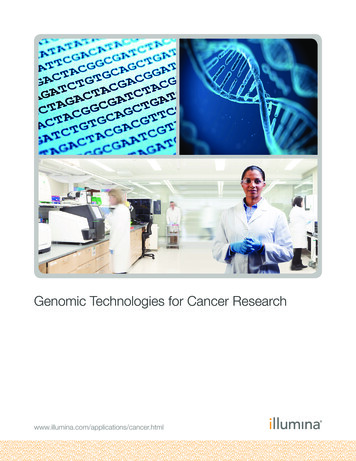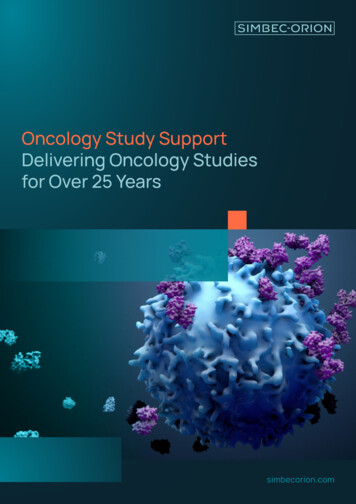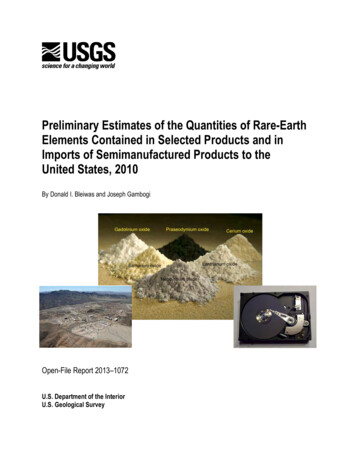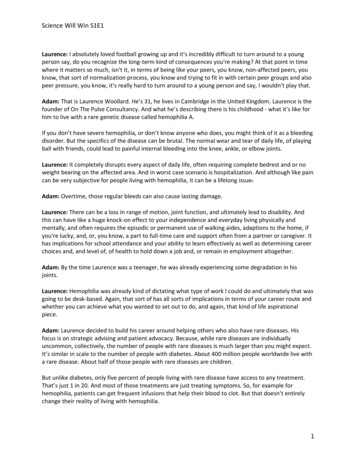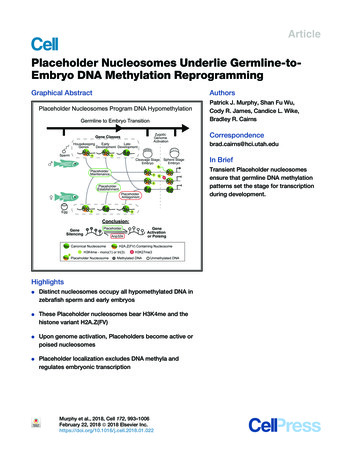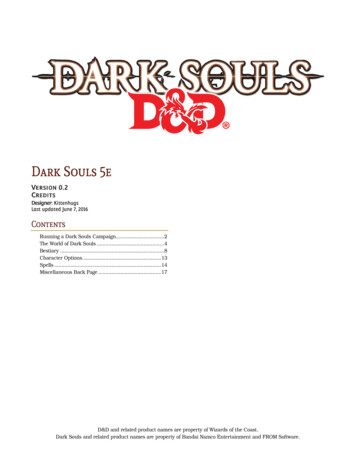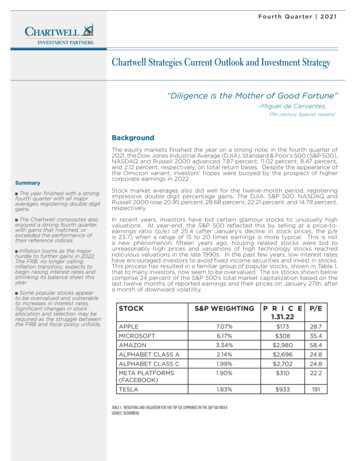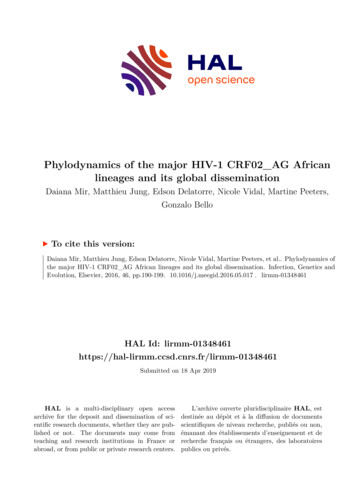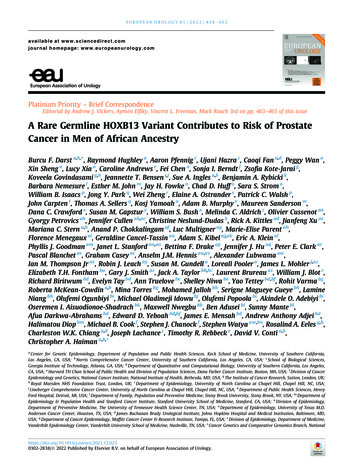
Transcription
EUROPEAN UROLOGY 81 (2022) 458–462available at www.sciencedirect.comjournal homepage: www.europeanurology.comPlatinum Priority – Brief CorrespondenceEditorial by Andrew J. Vickers, Aymen Elfiky, Vincent L. Freeman, Mack Roach 3rd on pp. 463–465 of this issueA Rare Germline HOXB13 Variant Contributes to Risk of ProstateCancer in Men of African AncestryBurcu F. Darst a,b,*, Raymond Hughley a, Aaron Pfennig c, Ujani Hazra c, Caoqi Fan a,d, Peggy Wan a,Xin Sheng a, Lucy Xia a, Caroline Andrews e, Fei Chen a, Sonja I. Berndt f, Zsofia Kote-Jarai g,Koveela Govindasami g,h, Jeannette T. Bensen i,j, Sue A. Ingles a,b, Benjamin A. Rybicki k,Barbara Nemesure l, Esther M. John m, Jay H. Fowke n, Chad D. Huff o, Sara S. Strom o,William B. Isaacs p, Jong Y. Park q, Wei Zheng r, Elaine A. Ostrander s, Patrick C. Walsh p,John Carpten t, Thomas A. Sellers q, Kosj Yamoah u, Adam B. Murphy v, Maureen Sanderson w,Dana C. Crawford x, Susan M. Gapstur y, William S. Bush x, Melinda C. Aldrich z, Olivier Cussenot aa,Gyorgy Petrovics ab, Jennifer Cullen ab,ac, Christine Neslund-Dudas k, Rick A. Kittles ad, Jianfeng Xu ae,Mariana C. Stern a,b, Anand P. Chokkalingam af, Luc Multigner ag, Marie-Elise Parent ah,Florence Menegaux ai, Geraldine Cancel-Tassin aa, Adam S. Kibel aj,ak, Eric A. Klein al,Phyllis J. Goodman am, Janet L. Stanford an,ao, Bettina F. Drake ap, Jennifer J. Hu aq, Peter E. Clark ar,Pascal Blanchet as, Graham Casey at, Anselm J.M. Hennis au,av, Alexander Lubwama aw,Ian M. Thompson Jr ax, Robin J. Leach ay, Susan M. Gundell a, Loreall Pooler a, James L. Mohler j,az,Elizabeth T.H. Fontham ba, Gary J. Smith az, Jack A. Taylor bb,bc, Laurent Brureau as, William J. Blot r,Richard Biritwum bd, Evelyn Tay bd, Ann Truelove be, Shelley Niwa be, Yao Tettey bd,bf, Rohit Varma bg,Roberta McKean-Cowdin a,b, Mina Torres bg, Mohamed Jalloh bh, Serigne Magueye Gueye bh, LamineNiang bh, Olufemi Ogunbiyi bi, Michael Oladimeji Idowu bj, Olufemi Popoola bi, Akindele O. Adebiyi bi,Oseremen I. Aisuodionoe-Shadrach bk, Maxwell Nwegbu bk, Ben Adusei bl, Sunny Mante bl,Afua Darkwa-Abrahams bd, Edward D. Yeboah bd,bf, James E. Mensah bd, Andrew Anthony Adjei bd,Halimatou Diop bm, Michael B. Cook f, Stephen J. Chanock f, Stephen Watya aw,bn, Rosalind A. Eeles g,h,Charleston W.K. Chiang a,d, Joseph Lachance c, Timothy R. Rebbeck e, David V. Conti a,b,Christopher A. Haiman a,b,*aCenter for Genetic Epidemiology, Department of Population and Public Health Sciences, Keck School of Medicine, University of Southern California,Los Angeles, CA, USA; b Norris Comprehensive Cancer Center, University of Southern California, Los Angeles, CA, USA; c School of Biological Sciences,Georgia Institute of Technology, Atlanta, GA, USA; d Department of Quantitative and Computational Biology, University of Southern California, Los Angeles,CA, USA; e Harvard TH Chan School of Public Health and Division of Population Sciences, Dana Farber Cancer Institute, Boston, MA, USA; f Division of CancerEpidemiology and Genetics, National Cancer Institute, National Institute of Health, Bethesda, MD, USA; g The Institute of Cancer Research, Sutton, London, UK;hRoyal Marsden NHS Foundation Trust, London, UK; i Department of Epidemiology, University of North Carolina at Chapel Hill, Chapel Hill, NC, USA;jLineberger Comprehensive Cancer Center, University of North Carolina at Chapel Hill, Chapel Hill, NC, USA; k Department of Public Health Sciences, HenryFord Hospital, Detroit, MI, USA; l Department of Family, Population and Preventive Medicine, Stony Brook University, Stony Brook, NY, USA; m Department ofEpidemiology & Population Health and Stanford Cancer Institute, Stanford University School of Medicine, Stanford, CA, USA; n Division of Epidemiology,Department of Preventive Medicine, The University of Tennessee Health Science Center, TN, USA; o Department of Epidemiology, University of Texas M.D.Anderson Cancer Center, Houston, TX, USA; p James Buchanan Brady Urological Institute, Johns Hopkins Hospital and Medical Institution, Baltimore, MD,USA; q Department of Cancer Epidemiology, Moffitt Cancer Center & Research Institute, Tampa, FL, USA; r Division of Epidemiology, Department of Medicine,Vanderbilt Epidemiology Center, Vanderbilt University School of Medicine, Nashville, TN, USA; s Cancer Genetics and Comparative Genomics Branch, 230302-2838/Ó 2022 Published by Elsevier B.V. on behalf of European Association of Urology.
EUROPEAN UROLOGY 81 (2022) 458–462459Human Genome Research Institute, National Institutes of Health, Bethesda, MD, USA; t Department of Translational Genomics, Keck School of Medicine,University of Southern California, Los Angeles, CA, USA; u Department of Radiation Oncology and Cancer Epidemiology, Moffitt Cancer Center & ResearchInstitute, Tampa, FL, USA; v Department of Urology, Northwestern University, Chicago, IL, USA; w Department of Family and Community Medicine, MeharryMedical College, Nashville, TN, USA; x Cleveland Institute for Computational Biology, Department of Population and Quantitative Health Sciences, CaseWestern Reserve University, Cleveland, OH, USA; y Epidemiology Research Program, American Cancer Society, Atlanta, GA, USA; z Department of ThoracicSurgery, Division of Epidemiology, Vanderbilt University Medical Center, Nashville, TN, USA; aa CeRePP & Sorbonne Universite, GRC n 5, AP-HP, TenonHospital, Paris, France; ab Center for Prostate Disease Research, Department of Surgery, Uniformed Services University of the Health Sciences, Bethesda, MD,USA; ac Department of Population and Quantitative Health Sciences, Case Western Reserve University, Cleveland, OH, USA; ad Department of PopulationSciences, City of Hope Comprehensive Cancer Center, Duarte, CA, USA; ae Program for Personalized Cancer Care and Department of Surgery, NorthShoreUniversity HealthSystem, Evanston, IL, USA; af School of Public Health, University of California, Berkeley, Berkeley, CA, USA; ag Univ Rennes, Inserm, EHESP,Irset (Institut de recherche en santé, environnement et travail) -UMR S 1085, Rennes, France; ah Centre Armand-Frappier Santé Biotechnologie, Institutnational de la recherche scientifique, University of Quebec, Laval, Quebec, Canada; ai Université Paris-Saclay, Université Paris-Sud, CESP (Center for Researchin Epidemiology and Population Health), Inserm, Team Cancer-Environment, Villejuif, France; aj Division of Urology, Brigham and Women’s Hospital/DanaFarber Cancer Institute, Boston, MA, USA; ak Washington University, St. Louis, MO, USA; al Glickman Urological & Kidney Institute, Cleveland Clinic, Cleveland,OH, USA; am SWOG Statistical Center, Fred Hutchinson Cancer Research Center, Seattle, WA, USA; an Division of Public Health Sciences, Fred HutchinsonCancer Research Center, Seattle, WA, USA; ao Department of Epidemiology, School of Public Health, University of Washington, Seattle, WA, USA;apDepartment of Surgery, Division of Public Health Sciences, Washington University School of Medicine, St. Louis, MO, USA; aq Sylvester ComprehensiveCancer Center and Department of Public Health Sciences, University of Miami Miller School of Medicine, Miami, FL, USA; ar Atrium Health/Levine CancerInstitute, Charlotte, NC, USA; as CHU de Guadeloupe, Univ Antilles, Inserm, EHESP, Irset (Institut de recherche en santé, environnement et travail) -UMR S1085, Rennes, France; at Center for Public Health Genomics, Department of Public Health Sciences, University of Virginia, Charlottesville, VA, USA;auDepartment of Preventive Medicine, Stony Brook University, Stony Brook, NY, USA; av George Alleyne Chronic Disease Research Centre and Faculty ofMedical Sciences, The University of the West Indies, Bridgetown, Barbados; aw School of Public Health, Makerere University College of Health Sciences,Kampala, Uganda; ax CHRISTUS Santa Rosa Health System and The University of Texas Health Science Center, San Antonio, TX, USA; ay Department of CellSystems and Anatomy, University of Texas Health Science Center at San Antonio, San Antonio, TX, USA; az Department of Urology, Roswell Park CancerInstitute, Buffalo, NY, USA; ba School of Public Health, Louisiana State University Health Sciences Center, New Orleans, LA, USA; bb Epigenetic and Stem CellBiology Laboratory, National Institute of Environmental Health Sciences, Research Triangle Park, NC, USA; bc Epidemiology Branch, National Institute ofEnvironmental Health Sciences, Research Triangle Park, NC, USA; bd Korle Bu Teaching Hospital, Accra, Ghana; be Westat, Rockville, MD, USA; bf University ofGhana Medical School, Accra, Ghana; bg Southern California Eye Institute, CHA Hollywood Presbyterian Medical Center, Los Angeles, CA, USA; bh HôpitalGénéral Idrissa Pouye, Dakar, Senegal; bi College of Medicine, University of Ibadan and University College Hospital, Ibadan, Nigeria; bj College of Medicine,University of Ibadan, Ibadan, Nigeria; bk College of Health Sciences, University of Abuja, University of Abuja Teaching Hospital and Cancer Science Center,Abuja, Nigeria; bl 37 Military Hospital, Accra, Ghana; bm Laboratoires Bacteriologie et Virologie, Hôpital Aristide Le Dantec, Dakar, Senegal; bn Uro Care,Kampala, UgandaArticle infoAbstractArticle history:Accepted December 22, 2021A rare African ancestry–specific germline deletion variant in HOXB13 (X285K,rs77179853) was recently reported in Martinican men with early-onset prostate cancer.Given the role of HOXB13 germline variation in prostate cancer, we investigated theassociation between HOXB13 X285K and prostate cancer risk in a large sample of 22361 African ancestry men, including 11 688 prostate cancer cases. The risk allele waspresent only in men of West African ancestry, with an allele frequency in men that ranged from 0.40% in Ghana and 0.31% in Nigeria to 0% in Uganda and South Africa, with arange of frequencies in men with admixed African ancestry from North America andEurope (0–0.26%). HOXB13 X285K was associated with 2.4-fold increased odds of prostate cancer (95% confidence interval [CI] 1.5-3.9, p 2 10 4), with greater riskobserved for more aggressive and advanced disease (Gleason 8: odds ratio[OR] 4.7, 95% CI 2.3–9.5, p 2 10 5; stage T3/T4: OR 4.5, 95% CI 2.0–10.0,p 2 10 4; metastatic disease: OR 5.1, 95% CI 1.9–13.7, p 0.001). We estimatedthat the allele arose in West Africa 1500–4600 yr ago. Further analysis is needed tounderstand how the HOXB13 X285K variant impacts the HOXB13 protein and functionin the prostate. Understanding who carries this mutation may inform prostate cancerscreening in men of West African ancestry.Patient summary: A rare African ancestry–specific germline deletion in HOXB13, foundonly in men of West African ancestry, was reported to be associated with an increasedrisk of overall and advanced prostate cancer. Understanding who carries this mutationmay help inform screening for prostate cancer in men of West African ancestry.Ó 2022 Published by Elsevier B.V. on behalf of European Association of Urology.Associate Editor:James CattoKeywords:African ancestryAllelic ageGeneticsHealth disparitiesHOXB13Prostate cancerRare genetic variantsPlease visit www.eu-acme.org/europeanurologyto answer questions on-line. The EU-ACME credits will then be attributed automatically.* Corresponding authors. Center for Genetic Epidemiology, Department of Population and PublicHealth Sciences, Keck School of Medicine, University of Southern California, 1450 Biggy Street, LosAngeles, CA 90033, USA. Tel. 1 323 442 0078 (B.F. Darst); Tel. 1 323 442 7755 (C.A. Haiman).E-mail addresses: bdarst@usc.edu (B.F. Darst), haiman@usc.edu (C.A. Haiman).
460EUROPEAN UROLOGY 81 (2022) 458–462The nonsynonymous rare germline HOXB13 G84E variant(rs138213197) is a major risk factor for prostate cancer,accounting for 5% of hereditary prostate cancer in menof European ancestry [1,2]. Rare prostate cancer HOXB13risk variants have also been observed in other populations,including missense variants G132E in Japanese men(rs1286034091; allele frequency 0.04%) [3] and G135Ein Chinese men (rs769634543; allele frequency 0.004%)[4]. Recently, a rare African ancestry–specific germline deletion variant in HOXB13 (rs77179853, allele frequency 0.2%),which removes the stop codon (X285K) and elongates theHOXB13 protein, was observed in three Martinican men(French West Indies) with early-onset prostate cancer (allele frequency 3.2%) [5]. Given the critical role of HOXB13germline variation in prostate cancer, we investigated theassociation between the HOXB13 X285K variant and prostate cancer risk in a large sample of men of African ancestry.This investigation included 11 688 prostate cancer casesand 10 673 controls from the African Ancestry Prostate Cancer (AAPC) Consortium, ELLIPSE/PRACTICAL OncoArray Consortium, California/Uganda Prostate Cancer Study, GhanaProstate Study, and Men of African Descent and Carcinomaof the Prostate (MADCaP) Network (Supplementary Tables 1and 2). The HOXB13 X285K variant was not included ongenome-wide association studies (GWAS) arrays used inthe African ancestry prostate cancer studies and wasimputed separately using the Trans-Omics for PrecisionMedicine (TOPMed) r2 and 1000 Genomes Project (1KGP)phase 3 reference panels; the variant was observed inapproximately 126 of 97 256 TOPMed participants andthree of 2504 1KGP participants (Supplementary material).We imputed 101 carriers among 22 361 men in the Africanancestry studies when using the TOPMed panel (imputationinfo score range across studies: 0.92–0.97) versus 60 whenusing 1KGP (imputation info score range across studies:0.68–0.82; Supplementary Table 3). The carrier concordance between imputation panels was 0% (SupplementaryFig. 1). Confirmatory genotyping of 82 TOPMed imputedcarriers, 42 1KGP imputed carriers, and 1431 imputed noncarriers confirmed 81 of 82 TOPMed but none of the 1KGPimputed genotypes (Supplementary Fig. 1 and Supplementary material). Other pathogenic and deleterious variantsin HOXB13 were observed in our African ancestry populations (Supplementary Table 4), but were extremely rareand not able to be imputed with high confidence and testedin the current study.HOXB13 X285K was present only in men of West Africanancestry (Fig. 1 and Supplementary Fig. 2), with an allelefrequency ranging from 0% in men from Uganda and SouthAfrica to 0.31% in controls from Nigeria and 0.40% in controls from Ghana (Supplementary Table 5). Allele frequencies ranged from 0% to 0.26% in African ancestry controlsfrom North America, the UK, and France (SupplementaryTable 5), likely due to the high degree of European admixture in these populations. Of the 22 361 men, those withgreater West African ancestry were found to have larger riskallele frequencies, ranging from 0.05% in cases with 0–20%West African ancestry to 0.90% in cases with 80–100% WestAfrican ancestry (Fisher’s exact test p 2 10 4; Supplementary Fig. 3 and Supplementary material).In studies where the variant was observed (10 477 casesand 9688 controls; Supplementary Table 2), the HOXB13Fig. 1 – Distribution of HOXB13 rs77179853 by genetic ancestry comparing principal components 1 and 2 calculated in our sample of 22 361 men of Africanancestry. Men carrying the rs77179853 delA risk allele are highlighted by black triangles.
461EUROPEAN UROLOGY 81 (2022) 458–462Table 1 – Association of HOXB13 germline variant rs77179853 with prostate cancer risk and disease aggressiveness.aGroupnCarriers, nRisk allele frequency (%)Overall prostate cancerControls (reference)9688280.14Cases10 477730.35Men of African ancestry from North AmericaControls (reference)8766210.12Cases9192440.24Men of African ancestry from West African countries (Ghana, Nigeria, and Senegal)Controls (reference)92270.38Cases920221.20Disease aggressivenessControls (reference)9180280.15Gleason 6 tumors3319190.29Gleason 7 tumors3056220.36Gleason 8 tumors b1126190.84Controls (reference)8918280.16Stage T1/T24784330.34Stage T3/T4959140.73Controls (reference)6526200.15Metastatic or PSA 100 ng/ml511111.08Controls (reference)9688280.14Cases with low-risk disease c,d2795120.21Cases with intermediate-risk disease c,d2721120.22Cases with high-risk disease d3082330.54Carrier frequency (%)OR (95% CI)p value0.290.70–2.42 (1.52–3.87)–2 100.240.48–1.98 (1.16–3.38)–0.010.762.39–3.99 �5.08–1.841.513.09–0.010.012 10–0.012 10–0.001–0.110.271 �3.15)(1.75–5.45)4544CI confidence interval; OR odds ratio; PSA prostate-specific antigen; RAF risk allele frequency.aAnalyses were limited to studies that carried the variant (see Supplementary Table 2).bCompared with 8329 controls (25 carriers, RAF 0.15%) as the CA UG study did not have Gleason 8 tumor case carriers.cCompared with 9400 controls (27 carriers, RAF 0.14%) as MADCaP did not have low- or intermediate-risk case carriers.dLow risk disease: Gleason 7, stage T1/T2, and PSA 10 ng/ml; intermediate-risk disease: Gleason 7, stage T1/T2, and PSA 10–20 ng/ml; high-riskdisease: Gleason 8–10, stage T3/T4, PSA 20 ng/ml, metastatic disease, or died of prostate cancer.X285K variant was significantly associated with 2.4-foldincreased odds of prostate cancer (95% confidence interval[CI] 1.5–3.9, p 2 10 4; allele frequency in cases 0.35%and controls 0.14%; Table 1 and Supplementary material).The allele frequency was more common in cases withhigher Gleason scores (0.29% in men with Gleason 6tumors [odds ratio {OR} 2.6, 95% CI 1.3–5.2, p 0.01],0.36% in men with Gleason 7 tumors [OR 2.3, 95%CI 1.2–4.2, p 0.01], and 0.84% in men with Gleason 8tumors [OR 4.7, 95% CI 2.3–9.5, p 2 10 5]), in casesdiagnosed with higher-stage disease (0.34% in men withstage T1/T2 disease [OR 2.3, 95% CI 1.3–4.1, p 0.01]and 0.73% in men with stage T3/T4 disease [OR 4.5, 95%CI 2.0–10.0, p 2 10 4]), and in cases with metastatic(or prostate-specific antigen 100 ng/ml) disease (1.08%[OR 5.1, 95% CI 1.9–13.7, p 0.001]; Table 1 and Supplementary Table 6).The absolute risk of prostate cancer was 15.9% (95% CI 15.9–16.0%) in noncarriers and 32.9% (95% CI 22.0–44.6%)in carriers by age 85 yr (Supplementary Fig. 4). We did notobserve associations between the variant and age at diagnosis (Supplementary Tables 7 and 8), family history of prostate cancer (Supplementary Table 9), or prostate-specificantigen levels (Supplementary Table 10).We estimated that the HOXB13 X285K variant aroseapproximately 1500–4600 yr ago (refer to SupplementaryFig. 5 and Supplementary material for details on allelicage estimates based on two complementary approaches)and likely occurred after the Bantu migration from Westernto Southern and Eastern Africa [6], which may explain whyit is found only in men of West African ancestry. These findings, together with the established prostate cancer susceptibility G84E founder mutation that is more prevalent inScandinavian populations [7] and the East Asian–specificG132E and G135E mutations [3,4], underscore the importance of ancestry-specific germline prostate cancer riskvariants in the HOXB13 gene.The HOXB13 X285K variant adds to growing evidence ofregional differences in Africa for prostate cancer risk variants [8,9] and provides the first evidence of a genetic factorthat is limited to specific African ancestry populations,although studies in other populations are needed to betterunderstand the distribution of this variant in Africa. Thisinvestigation also demonstrates the importance and necessity of building diverse reference panels to facilitate the discovery of rare ancestry-specific risk variants and the needfor larger sequencing studies in prostate cancer. At anexome-wide significance threshold of p 5 10 7, 18 000cases and 18 000 controls would be needed to detect anOR of 2.4 for an allele frequency of 0.14% (eg, HOXB13X285K) with 90% power. The X285K stop codon is predictedto result in a 34% elongation of the HOXB13 protein, extending it by 96 amino acids [10]. Further studies are needed tounderstand how the HOXB13 X285K variant impacts thefunction of this homeobox transcription factor in the prostate. Understanding who carries this mutation may helpinform screening for prostate cancer in men of West Africanancestry.Author contributions: Burcu F. Darst had full access to all the data in thestudy and takes responsibility for the integrity of the data and the accuracy of the data analysis.Study concept and design: Haiman.Acquisition of data: Wan, Sheng, Xia, Andrews, Berndt, Kote-Jarai, Govindasami, Bensen, Ingles, Rybicki, Nemesure, John, Fowke, Huff, Strom,Isaacs, Park, Zheng, Ostrander, Walsh, Carpten, Sellers, Yamoah, Murphy,Maureen Sanderson, Crawford, Gapstur, Bush, Aldrich, Cussenot, Petrovics,
462EUROPEAN UROLOGY 81 (2022) 458–462Cullen, Neslund-Dudas, Kittles, Xu, Stern, Chokkalingam, Multigner, Par-Acknowledgments: A full listing of acknowledgments is detailed in theent, Menegaux, Cancel-Tassin, Kibel, Klein, Goodman, Stanford, Drake,Supplementary material.Hu, Clark, Blanchet, Casey, Hennis, Lubwama, Thompson Jr, Leach, Gundell,Pooler, Mohler, Fontham, Smith, Taylor, Brureau, Blot, Biritwum, Tay, Tru-Appendix A: Supplementary dataelove, Niwa, Tettey, Varma, McKean-Cowdin, Torres, Jalloh, Gueye, Niang,Ogunbiyi, Idowu, Popoola, Adebiyi, Aisuodionoe-Shadrach, Nwegbu, Adusei, Mante, Darkwa-Abrahams, Yeboah, Mensah, Adjei, Diop, Cook, Chanock, Watya, Eeles, Lachance, Rebbeck, Conti, Haiman.Analysis and interpretation of data: Darst, Hughley, Pfennig, Hazra, Fan,Wan, Sheng, Xia, Chen, Chiang, Lachance, Conti, Haiman.Drafting of the manuscript: Darst, Pfennig, Hazra, Fan, Chiang, Lachance,Conti, Haiman.Critical revision of the manuscript for important intellectual content: Darst,Hughley, Sheng, Multigner, Crawford, Lachance, Conti, Haiman.Statistical analysis: Darst, Hughley, Pfennig, Hazra, Fan, Wan, Sheng, Xia.Obtaining funding: Conti, Haiman.Administrative, technical, or material support: Wan, Sheng, Xia, Gundell,Pooler.Supervision: Haiman.Other: None.Financial disclosures: Burcu F. Darst certifies that all conflicts of interest,including specific financial interests and relationships and affiliations relevant to the subject matter or materials discussed in the manuscript (eg,employment/affiliation, grants or funding, consultancies, honoraria, stockownership or options, expert testimony, royalties, or patents filed,received, or pending), are the following: None.Funding/Support and role of the sponsor: This work was supported bythe National Cancer Institute at the National Institutes of Health, grantsU19 CA148537, U19 CA214253, R01 CA165862, K99CA246063 and theProstate Cancer Foundation, grant 20CHAS03. Dr. Burcu F. Darst was supported in part by an award from the Achievement Rewards for CollegeScientists Foundation Los Angeles Founder Chapter.Supplementary data to this article can be found online erences[1] Ewing CM, Ray AM, Lange EM, et al. Germline mutations in HOXB13and prostate-cancer risk. N Engl J Med 2012;366:141–9.[2] Xu J, Lange EM, Lu L, Zheng SL, et al. HOXB13 is a susceptibility genefor prostate cancer: results from the International Consortium forProstate Cancer Genetics (ICPCG). Hum Genet 2013;132:5–14.[3] Momozawa Y, Iwasaki Y, Hirata M, et al. Germline pathogenicvariants in 7636 Japanese patients with prostate cancer and 12 366controls. J Natl Cancer Inst 2020;112:369–76.[4] Lin X, Qu L, Chen Z, et al. A novel germline mutation in HOXB13 isassociated with prostate cancer risk in Chinese men. Prostate2013;73:169–75.[5] Marlin R, Creoff M, Merle S, et al. Mutation HOXB13 c.853delT inMartinican prostate cancer patients. Prostate 2020;80:463–70.[6] Choudhury A, Aron S, Botigue LR, et al. High-depth African genomesinform human migration and health. Nature 2020;586:741–8.[7] Karlsson R, Aly M, Clements M, et al. A population-basedassessment of germline HOXB13 G84E mutation and prostatecancer risk. Eur Urol 2014;65:169–76.[8] Lachance J, Berens AJ, Hansen MEB, Teng AK, Tishkoff SA, RebbeckTR. Genetic hitchhiking and population bottlenecks contribute toprostate cancer disparities in men of African descent. Cancer Res2018;78:2432–43.[9] Harlemon M, Ajayi O, Kachambwa P, et al. A custom genotypingarray reveals population-level heterogeneity for the genetic risks ofprostate cancer and other cancers in Africa. Cancer Res2020;80:2956–66.[10] Akbari MR, Trachtenberg J, Lee J, et al. Association betweengermline HOXB13 G84E mutation and risk of prostate cancer. JNatl Cancer Inst 2012;104:1260–2.
CA, USA; e Harvard TH Chan School of Public Health and Division of Population Sciences, Dana Farber Cancer Institute, Boston, MA, USA; f Division of Cancer Epidemiology and Genetics, National Cancer Institute, National Institute of Health, Bethesda, MD, USA; g The Institute of Cancer Research, Sutton, London, UK;
